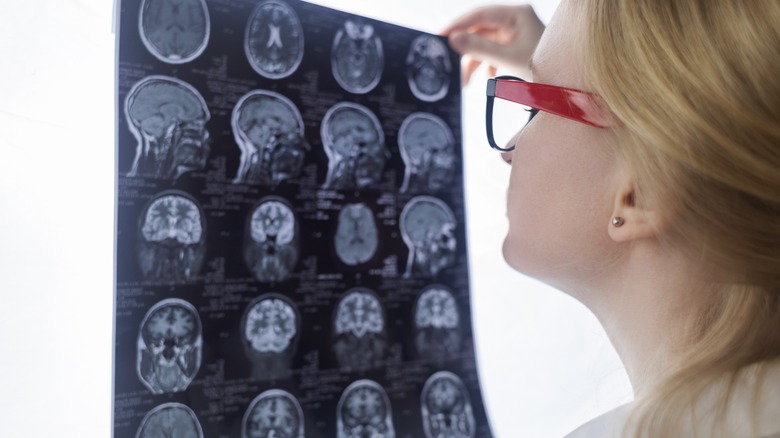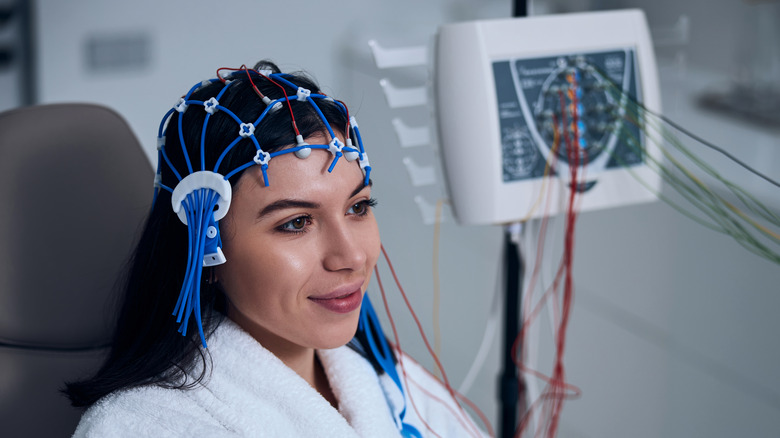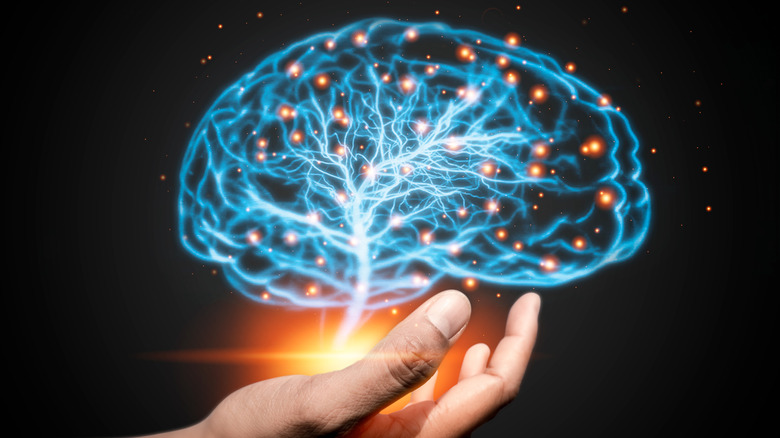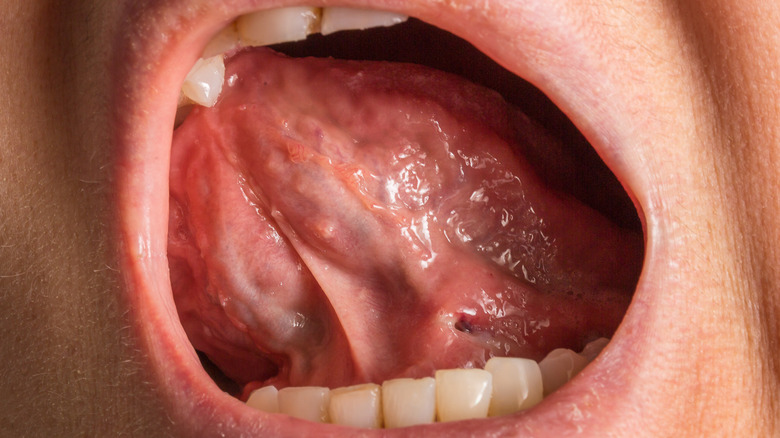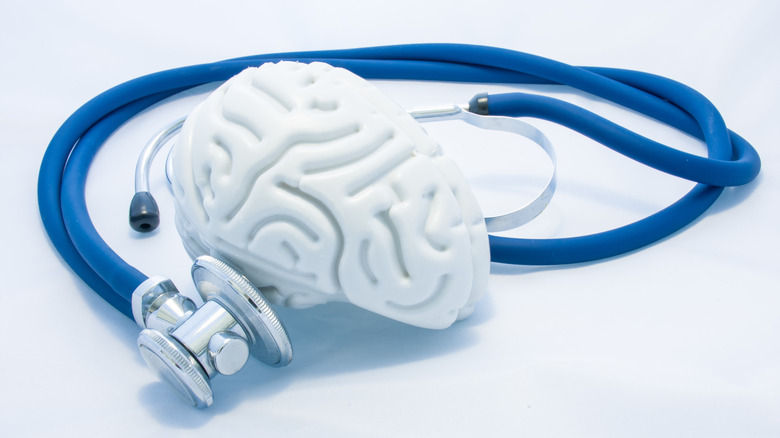Myths You Should Stop Believing About Epilepsy
Epilepsy is a disorder that occurs when electrical activity barrages your brain (via Mayo Clinic). As a result, the messages sent through your nervous system get discombobulated, causing you to have a seizure. Seizures vary and range in length and type. Seizures can cause anything from a look of daydreaming to involuntary movements of your arms and legs. Those with epilepsy report confusion, loss of consciousness, stiff muscles, and anxiety as prominent symptoms.
Defined as a "seizure disorder," epilepsy affects about 3.4 million Americans, according to the Centers for Disease Control and Prevention (CDC). Epilepsy is among the most diagnosed neurological disorders, coming in fourth after migraines, stroke, and Alzheimer's disease (via Epilepsy Currents). Doctors diagnose patients with the chronic condition after they experience at least two seizures that occur at least 24 hours apart without any known cause (via Mayo Clinic). Medications help control seizure frequency in the majority of patients. Some patients with uncontrollable seizures require surgery. Others with epilepsy outgrow the condition. Knowing the facts about epilepsy is essential to help yourself or someone else with the disease.
Myth: There's only one type of epilepsy
There are four types of epilepsy, and the type you're diagnosed with depends on where the electrical surge starts, how your brain is affected, and the type of seizure that results (via Medical News Today). Approximately 30% of those diagnosed with epilepsy have generalized epilepsy (via Healthline). Most often diagnosed in childhood, the seizures associated with generalized epilepsy begin on both sides of the brain. Loss of consciousness is common. However, you may or may not experience body movement.
Focal epilepsy, or seizures that begin on one side of your brain, affect over half of those diagnosed with the disease. Focal epileptic seizures don't always remain in the same part of the brain. Symptoms often begin with a feeling of dread, as if something terrible is about to happen. While movement doesn't necessarily occur and consciousness varies, those with focal epilepsy report changing emotions and both hot and cold flashes. Combined general and focal epilepsy have more than one type of seizure that can occur alone or simultaneously. Symptoms depend on the kind of seizure you have. Often one type is more prevalent than another. Finally, doctors tend to diagnose unknown epilepsy in those who have a normal electroencephalogram (EEG). This makes it challenging to determine where the electrical surge begins. Symptoms of seizures associated with unknown epilepsy include loss of consciousness and movement.
Myth: People with epilepsy have one kind of seizure
Epileptic seizures are classified into two categories: generalized and focal (via CDC). In addition, generalized seizures are split into two different types: absence and tonic-clonic. Absence seizures make it appear as if you are daydreaming. Rapid blinking often accompanies absence seizures. In regards to epilepsy, the term "tonic" refers to stiffened muscles, while "clonic" refers to convulsions. Therefore, the symptoms accompanying a tonic-clonic seizure include trembling and a loss of awareness. Until recently, tonic-clonic seizures were referred to as grand mal seizures.
Focal seizures originate on one side of the brain and are divided into three categories: simple, complex, and secondary generalized. Simple focal seizures cause muscle spasms and may leave an odd taste in your mouth. Confusion usually accompanies complex focal seizures. Although classified as a focal seizure, secondary generalized seizures only begin that way. As the name suggests, secondary generalized seizures spread throughout your brain and become generalized seizures.
In all cases, seizures must be repetitive to be classified as epileptic (via Johns Hopkins Medicine).
Myth: Everyone who has a seizure has epilepsy
One in 100 Americans will have a seizure or be diagnosed with epilepsy in their lifetime (via Epilepsy Foundation). Brain damage and family history raise your chances of developing epilepsy. If there is no known cause for the seizure, you have about a 50% chance of having a second one at some point (via the American Association of Neurological Surgeons). After an additional seizure, the likelihood of a reoccurrence skyrockets to 80%. In addition, if you are diagnosed with an injury or infection at the time of your seizure, the possibility of repetition significantly increases.
Nonepileptic seizures fall into several different categories (via National Institute of Neurological Disorders and Stroke). First seizures are often brought on by another medical issue such as a change in blood sugar level (especially if you have diabetes), problems with your liver or kidneys, and altered salt levels. Febrile seizures are brought on by high fevers, and are most prevalent in small children. Nonmedical seizure agents include stress, not eating, and missing sleep. Prevention of the underlying problem may help prevent additional seizures.
Nonepileptic events present as seizures without the associated electrical issues in the brain. Narcolepsy, Tourette syndrome, and cardiac arrhythmia can all present as epilepsy. Another common problem often misdiagnosed as epilepsy is psychogenic nonepileptic seizures (PNES). PNES is most often the result of a traumatic event and is best treated psychiatrically.
Myth: Epilepsy is contagious
While contagious medical issues can trigger epilepsy, you cannot catch or get epilepsy from someone with the disease, according to the World Health Organization. While only half of those with the disorder know the cause, the main culprits are usually genetic factors, infections, head trauma, or abnormalities in brain structure (via Mayo Clinic).
If a close family member has the disease, you have a greater chance of being diagnosed not only with epilepsy, but with the same type of epilepsy as your relative. However, in some cases, you not only have to possess the gene, you also have to be exposed to similar environmental circumstances. Traumatic head injuries can also cause epilepsy, as can brain tumors and strokes. In addition, certain viruses such as meningitis, HIV, encephalitis, and some parasitic infections, increase your risk. Some developmental disorders like autism have also been linked to epilepsy.
The best way to lower the possibility of developing epilepsy is to take precautions. Wear a helmet when participating in activities associated with head injury. Eat a healthy diet and see your doctor regularly to lower your risk of stroke and other illnesses related to epilepsy. Prenatal checkups help protect you and your baby from epilepsy.
Myth: It's easy to tell when a seizure is about to happen
Epilepsy is a spectrum disorder, meaning the disease presents itself differently in everyone diagnosed. In fact, you could have a different experience each time you have a seizure. And this can make it difficult to determine when a seizure will occur (via Epilepsy Foundation).
Some epileptic patients experience a prodrome stage before their seizure occurs — this could happen for days, hours, or minutes before the seizure (via Healthline). During the prodrome stage, your mood could change. You may feel irritable or anxious. You could develop a headache. A change in awareness or consciousness, known as an "aura," is also a warning sign or initial symptom of a seizure (via Epilepsy Foundation). Some people have auras before the onset of their seizure, while others seem to pass out after the seizure has begun. Deja vu, hallucinations, confusion, numbness, and an increase in both heart rate and blood pressure are common during auras.
If you sense an oncoming seizure, let the people around you know, and stay away from water, heights, and open flames (via Healthline). Also, do not drive until the seizure has passed. If you are with someone who indicates they are about to have a seizure, help them to a safe place on the ground and move everything out of the way. Whether you are having a seizure or helping someone who is, be sure to keep track of symptoms before, during, and after the episode. Also, keep track of the duration of the seizure.
Myth: During a seizure, a person could swallow or choke on their tongue
Contrary to popular belief, you cannot swallow your tongue during an epileptic seizure (via Johns Hopkins Medicine). If you feel or look under your tongue, you will notice the lingual frenulum, a piece of tissue that connects the base of your tongue to the bottom of your mouth — and this connection makes it a physical impossibility that you could swallow your tongue (via Medical News Today).
However, while you may not be able to swallow your tongue, it can end up in a position that hinders airflow, especially if you are lying on your back during an epileptic seizure. The tongue and anything in the seizing person's mouth could fall into the back of the throat and cut off breathing. While it's challenging to ensure your own position during a seizure, those around the person should know what to do. To ensure overall safety, move sharp objects away from the person in distress. Maneuver them so they're resting on their side on the floor, with their upper knee bent to support their body as it angles downward. Then, to ensure the person can breathe, double-check that there's nothing in their mouth, and that their tongue has fallen forward.
Myth: Seizures are painful
A study published in Epilepsy & Behavior found that less than 1% of those who experience seizures feel pain during the event itself. One reason for this lack of pain may be a loss of consciousness (via Healthline). If you aren't cognizant during an episode, or any period of time, you can't and won't feel pain. However, this does not mean that having a seizure is entirely pain-free. Some seizures do come with side effects, or events that occurred during the seizure could prove to be physically uncomfortable afterward.
According to the Epilepsy Foundation, some people might feel headaches prior to a seizure, but this warning or pre-ictal headache doesn't last long, and the type of pain varies. It's more common for those who have epileptic seizures to feel a headache afterward. Almost half of all patients report suffering from a postictal headache. In addition, some patients report symptoms of intense throbbing lasting over 24 hours.
Another cause of pain related to seizures are injuries that result from involuntary movements (via Healthline). For example, a break, bruise, or cut could be painful if you fall. Also, soreness could result from muscle contractions that occur during the seizure.
Myth: Epilepsy is most common in children
Kids get sick more often than adults, due, in part, to their size (via CDC). Because they're small, they breathe in more air per pound (and therefore inhale more germs for their body weight than adults do). Children's skin is also thinner than that of adults, making them less able to defend against invasion. However, because a contagious illness does not cause epilepsy, it is not more prevalent in children. In fact, childhood epilepsy accounts for only one-quarter of new diagnoses (via the Deutsches Ärzteblatt International). In total, only half a percent of patients with epilepsy are children.
According to the Child Neurology Foundation, this myth may stem from the fact that nearly half of the children with epilepsy have been diagnosed with other issues that complicate the disease. These include learning delays, Attention Deficit Disorder (ADD), and other psychological problems. However, on a more positive note, more than half of the children who have epilepsy as a child outgrow the disease by adulthood. Still more can control their condition with one medication so they can live relatively normal lives.
Myth: Strobe lights always trigger seizures in people with epilepsy
No two people with epilepsy present the same (via Epilepsy Foundation). However, some common conditions trigger seizures. One of the most commonly known is strobe lights. Flashing lights triggers seizures in approximately 3% of those with epilepsy (via Epilepsy Foundation). This is compared to just over 1% of the general population tested who had abnormal EEG results when strobe lighting was introduced.
Photosensitivity affects more girls than boys. However, boys tend to be exposed to more flashing lights than girls, resulting in more seizures. Other factors that determine how triggering strobe lights are to those with epilepsy include the number of flashes per second, the lights' intensity and color, and the person's proximity to the light source. For example, lights that flash between five and 30 times are more likely to produce seizures, as is the color red.
Penn Medicine lists missing medication as the number one factor that triggers an epileptic seizure. Other common elements include missing meals and sleep, too much caffeine or alcohol, and your menstrual cycle. On their own, these determinants are more likely to produce a seizure than strobe lighting (via Epilepsy Scotland).
Myth: People with epilepsy should not get pregnant
While many factors go into deciding to have a child, preexisting conditions like epilepsy don't have to deter you. There are over one million women with epilepsy of childbearing age, and they will have about 24,000 babies annually (via Epilepsy Foundation). It's best to start planning before you get pregnant. Inform your Ob/Gyn and neurologist of your choice, as some anti-epileptic drugs (AEDs) decrease folic acid levels in your body (via The University of Texas Southwestern Medical Center). Folic acid helps in fetal brain, spine, and spinal cord development — so it's crucial to make sure your growing baby is receiving adequate amounts. Your doctors may change your medication to a safer one. Doctors also recommend taking additional folate, above and beyond what is typically advised.
Pregnancy also increases the likelihood of seizures by up to 30%, especially during the first and last trimesters (via Epilepsy Foundation). This is primarily attributed to increases in estrogen and decreases in the amount of medication in your blood. Additionally, water retention and less sleep also increase seizure tendency. So again, monitoring is key to keeping seizures at bay and keeping you and your baby safe.
A related fear is passing on the diagnosis. However, the probability of your child having epilepsy because you do is only 5% (via Penn Medicine). The increase is negligible if the father also has the disease or if you also received the disease through your family tree. And if your child does wind up with epilepsy, they can still lead a productive, happy life.
Myth: Epilepsy is uncontrollable
The CDC reported that as of 2015, more than half of those diagnosed with epilepsy were still seizing even after taking prescribed medication for one year. There are a few explanations as to why this might be the case.
Some patients may be misdiagnosed — indeed, the Epilepsy Foundation reports that 13% of those treated for epilepsy actually had a different medical condition altogether. Others might be taking the wrong medication, or the wrong dose of medicine. Drug interaction between your seizure medicine and medication taken for other medical issues is another contributing factor, as is the ability to remember to take your prescriptions as directed. Other lifestyle issues that interfere with epileptic seizure control are stress and alcoholism. Also, if your blood sugar levels aren't properly monitored, it could lead to a seizure.
If your specialist finds that you genuinely have drug-resistant epilepsy and no medication helps you control your seizures, there are other options. During a resection procedure, doctors remove the part of your brain where the seizures start (via Healthline). If the area is too big, the nerve pathways to and from the seizure origination area are cut. Other options include vagus nerve stimulation, wherein a special magnet is placed in your chest, or deep brain stimulation, where electrodes get placed in the brain. Ask your doctor about new studies and medical trials.
Myth: If you have epilepsy, you can't drive
An research review published in Epilepsy Currents reports that driving with an epileptic diagnosis is less dangerous than driving under the influence of alcohol. In fact, "only 11% of all car crashes involving individuals with epilepsy are due to seizures" according to the authors.
In the U.S., laws regulating driving by those with medical conditions, including epilepsy, vary by state (via Epilepsy Foundation). Most places require you to be seizure-free for six months to a year before you're allowed to drive. After that, you may need to periodically submit a doctor's note or other medical evaluation to continue driving. Statistics show that waiting for seizures to be controlled for a year prevents "about 80% of all crashes associated with seizures" (via Epilepsy Currents).
As the review authors note, shorter non-seizure waiting times make it more likely that patients will report their diagnosis to authorities and abide by legal restrictions. They also point out that studies have not shown a significant increase in the risk of a car crash or death due to a seizure with a three-month seizure-free period versus a year-long seizure-free wait time.
Myth: You should restrain someone having a seizure
While there are several steps you can take to ensure the safety of someone having a seizure, experts at the CDC warn not to try to restrain them or restrict their movements. Trying to prevent movement will only increase the probability of injury to you and the person with epilepsy. Impeding motion does nothing to stop the seizure (via Penn Medicine). Additionally, CPR is not required, as the seizing person will regain normal breathing once the seizure stops.
Instead, try to keep yourself and everyone around you calm. Make a note of when the seizure starts and stops, and see if the person has a medical bracelet that alerts others to their medical condition. If you know what type of seizure the person is having, you will be better prepared to assist. Absence seizures do not require intervention. Carry on as usual as they only last a few seconds, and the person is usually unaware of the episode (per Medical News Today). The same is true for simple focal seizures.
If the person has a tonic-clonic seizure, ensure they're in a safe place and cannot fall. Then, roll them on their side with something soft under their head and time the seizure. The rules apply for complex focal seizures and secondary generalized seizures.
Myth: If someone has a seizure, they have to go to the hospital
Many people may reflexively want to dial 911 when they see a person in distress. However, EMS is not always needed, especially when it comes to people having epileptic seizures. Instead, if you see someone having a seizure, ensure that person is safe from injury and can breathe properly (via American College of Emergency Physicians).
However, it's best to call for an ambulance if the seizure lasts more than five minutes or if this is the first time the person is experiencing this type of seizure. Other reasons to call emergency services include successive seizures, breathing difficulty, or if the person is injured during the episode (via CDC). If the epileptic person has other health issues, including a fever, pregnancy, or diabetes, they should go to a hospital. They should also do so if confusion or unconsciousness continues well after the seizure has ended.
Though it's best to err on the side of caution, be aware that medical professionals may not be able to do much to help the person who had the seizure. They should keep a record of their seizures and contact their providers to discuss their specific condition.


